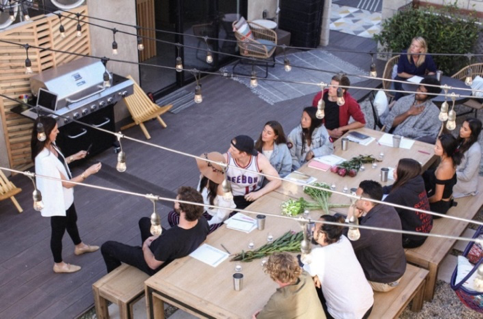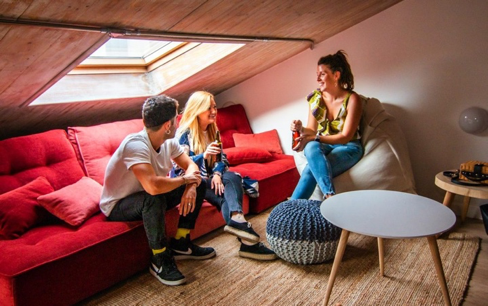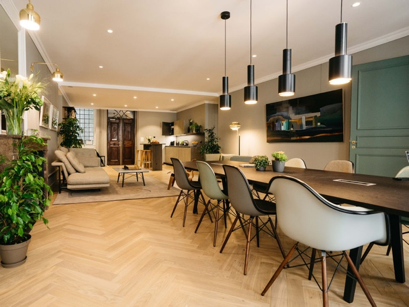`Humans are by nature social animals´. While communal living goes back to the earliest days of human cohabitation, the latest trends explain the growth of communal living concepts in recent years: the sharing economy, changing patterns of work and social distancing, which is bringing an increase in urban loneliness. Furthermore, the UN predicts that 68% of the world population will live in urban areas and in more than 40 megacities by 2050. The need for a sense of belonging to combat urban loneliness is becoming essential.
Hospitality concepts have an opportunity to contribute to a more connected society by offering guests the possibility to interact with others and connect with the local community. Hence, recent research conducted as part of my Bachelor thesis aimed to answer the following MRQ (Main Research Question): What are the key success factors of community-building in hospitality real estate?
What is community?
Even though the term is vague, the most general view on community involves people who are connected by similar visions, values, interests, or challenges in a physical environment. Community-building is around likeminded people sharing, establishing connections, building relationships, and achieving a sense of belonging. In hospitality, community is being provided by either the service level, the staff, and/or by transferring part of the ownership of the experience onto the members.
What are the most successful community-building techniques?
Community-building is an organic process without a one-size-fits all approach. The process needs to align with the community identity. However, the study confirmed that co-creation – the involvement of members in the community-building decision-making process – is an efficient technique to increasing community engagement. A way of implementing this approach is by facilitating members the tools, resources and systems to build the community organically. For instance, Open Doors provides their members with communal living workshops or cleaning systems. Another generalized view is that it is important to take a 360-degree approach for every aspect of the community: from the Website design to the staff, all needs to be aligned.
How is community success measured?
With regards to community success, the concepts of accountability, commitment, and vulnerability reappeared in multiple occasions, leading to the following definition: A real and successful community is reached when members give without expecting anything in return, help each other out; a place where absolute vulnerability and psychological safety is achieved. Currently, there is little focus on measuring community success. The most common indicators used include attendance % to events, length of stay, word of mouth, collected feedback, online ratings and NPS score (guest/resident likeliness to recommend on a scale of 1-10).
Nonetheless, operators could consider a more holistic approach to community success and focus on measuring the community well-being with indicators directed towards loneliness and happiness levels and the broader impact of the community on the neighbourhood. One collaborator in my research, Matt Lesniak, Head of Impact and Innovation at Conscious Coliving, shared this view on community success adding: Coliving developers and operators need to measure what they treasure. This means ensuring resident wellbeing, community cohesion and environmental sustainability, and coming up with measurement and reporting systems to track this. In order to create flourishing and thriving coliving communities, community, wellbeing and sustainability must be embedded into the products, experiences and business strategies of coliving businesses.
What are the key success factors for community-building in hospitality?
When building communities, hospitality concepts should consider the following elements:
- Community identity: the first step in building a successful community is defining the community identity; its vision, mission and values.
- Spatial design: programming spaces that facilitate human interactions is key. There is an open debate around what is best; either creating a main communal area or clusters, smaller shared spaces. Also, flexibility and personalization of spaces is a factor that can contribute to increasing members’ engagement.
- Communication: authentic, honest, transparent and consistent. While co-living spaces focus on internal communication with its residents, serviced apartments put a higher emphasis on external communication. This can be attributed to the fact that co-living spaces have a selection process to filter residents, while serviced apartments rely on communication channels (social media, Website) to attract the right audience.
- Community programming: events are seen as an opportunity to connect members. Choosing an appropriate spatial design, a theme or ritual; focusing on small goals, audience and on a common ground are amongst the factors that can contribute success. Besides, it was found that establishing partnerships with local businesses can help hospitality concepts achieve higher integration in the local neighbourhood. Indeed, Kelley Ralph, Experience Manager at Edyn, added that it is essential “to show the local neighborhood that you care, that you are making the effort to connect”.
- Safety: to provide members with a space where they can feel vulnerable, hence reach deeper connections, both physical and emotional safety are key.
- Staff: they act as facilitators of human connections, a factor that is more relevant in serviced apartments than in co-living.
On top of these factors, a strong selection and onboarding process is key in co-living spaces to attract the right members and to establish clear expectations regarding accountability and commitment. Other important factors explored include technology, which will stay after Covid-19 as a complimentary tool to improve members’ experience; and feedback, as listening to the community is essential to build members trust and to track community success.
While social isolation and distancing requirement measures have limited the use of communal areas, the pandemic has proved that the need for physical human connections is greater than ever. Indeed, the Australian Bureau of Statistics identified loneliness as the most common personal stressor during lockdown. Hence, if communal concepts in hospitality create spaces where communities can flourish, they can help mitigate one of the most extended health problems during the 21st century.
This research would not have been possible without the collaboration and insights from:
- Monika Kanokova, Co-Founder at New Standard Studio
- Jon Hormaoetxe, GM at Sun & Co Coliving
- Anastasia Opisov, Development Manager at Adina Apartments
- Lucas Crobach, Founder at Press Start Real Estate
- Natalia Skotnicka, Operations Manager Poland at Vonder Coliving
- Puck Van Opdorp, Connector Events & Partnerships at The Student Hotel
- Matt Lesniak, , Head of Impact and Innovation at Conscious Coliving
- Kelley Ralph, Experience Manager at Edyn
About Alba Pons
 Alba, originally from Spain, discovered her passion for the hospitality industry after collecting her fist experience at the Sales & Marketing department at Jardin Tropical, a 4-star resort in Tenerife. Then, she started her studies of International Hospitality Management at “Hotelschool The Hague” in Amsterdam, The Netherlands. Prior to HoCoSo, Alba has worked at Anantara Bophut Ko Samui (Thailand). Her interest in both market research and concept development, led Alba to join HoCoSo on November 2019 as Hotel Analyst Intern. She has graduated in 2020.
Alba, originally from Spain, discovered her passion for the hospitality industry after collecting her fist experience at the Sales & Marketing department at Jardin Tropical, a 4-star resort in Tenerife. Then, she started her studies of International Hospitality Management at “Hotelschool The Hague” in Amsterdam, The Netherlands. Prior to HoCoSo, Alba has worked at Anantara Bophut Ko Samui (Thailand). Her interest in both market research and concept development, led Alba to join HoCoSo on November 2019 as Hotel Analyst Intern. She has graduated in 2020.
About HoCoSo
HoCoSo are advisors with a difference.
We create tailor-made and innovative solutions for clients’ hospitality-led projects by bringing together the optimum team of sector specialists.
Jonathan Humphries, Chairman and Owner of HoCoSo, and his direct team specialize in the extended-stay, co-living, and hotel-alternatives hospitality market; luxury, lifestyle and boutique hotels; and resort developments in Europe, the Middle East and Africa (EMEA). Our strengths lie in the following core services:
- Product & Concept Creation, for portfolio & individual asset developments.
- Strategic Development Projects with a focus on new-market / new-concept business expansion planning, operator selection, market and financial feasibility studies.
- Transformative Asset Management for brand re-positioning, asset re-evaluation and concept re-structuring.
- Hospitality Education for companies and academic institutions, with a focus on bespoke course development, training and teaching.
- Workshops, Keynotes and Conference Moderating for boards, leading international conferences and incubators.












Leave A Comment